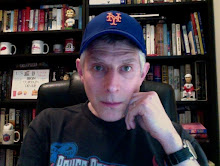That was the dedication on the biggest model of the Earth ever made. It was called Unisphere.
 |
| A different kind of creationism |
Though it took 64 years for Major League Baseball to award any sort of trophy to its World Series winner and another 32 years for that trophy to include any representation of the game's home planet, the Unisphere -- for a time -- was a ubiquitous marketing companion of the New York Mets.
Like its 1939-40 antecedent, the 64-65 World's Fair strived to put an optimistic spin on bleak circumstance.
 |
| NYWF souvenir glassware and the ever-present jet over Shea |
"Peace Through Understanding" was the theme of the fair, but war through misunderstanding was imminent in southeast Asia.
Good neighbors, the Mets and the Fair embraced the Unisphere -- Earth -- as a their common cross-promotional symbol. Peace through understanding at least reigned in Queens.
.283 Winning Percentage
Born just two years earlier, the Mets were the 10th-best team in the 10-team National League. Over their first two seasons, they'd lost an astonishing 231 games while winning just 91. Their home had been the decrepit Polo Grounds in upper Manhattan, abandoned by the New York Giants when they moved to San Francisco in 1958.
 |
The '64 NYWF guide
and Unisphere logo.
|
Now the Mets had a new residence: the 55,000-seat multipurpose Shea, midway between LaGuardia Airport and the Fair.
The Fair was grand -- too grand for the Bureau of International Expositions, which refused to sanction it because it would run for two years, not one -- and costly to construct and operate.
With easy access via footbridge over the Long Island Railroad and subway tracks that separated the fairgrounds from the stadium, cross-promotion made good sense.
Come for the Fair, stay for the game, or vice versa.
A Unisphere logo appeared on the cover of the official NYWF '64 guidebook, with the story of the metal earth's creation within. The '65 edition would feature a double-truck photo of Shea, calling it "sporting neighbor to the fair.'' Both books listed the new ballpark as an attraction.
The Mets reciprocated in kind, adding an orange and blue Unisphere logo to the team's 1964 and 1965 yearbooks. They even wore a form of it as a patch on their uniform sleeves (which didn't alter their performance on the field).
Cover art for the regular season game program -- billed as the "World's Fair Edition" -- also incorporated the big steel ball next door. A back cover ad featured the 'sphere and dinosaurs.
 |
| The '64 Mets' season program front... |
 |
| ... and back |
Unisphere would also make the program cover for Shea's one and only MLB All Star Game. That contest, won by the NL 7-4 on a ninth-inning walk-off homer, featured the Mets' first All Star starter, second-baseman Ron Hunt, who hit .303 that year.
 |
| The best baseball players in the world come to William A. Shea Stadium |
The team would finish that year a dreadful 53-109, a two game improvement from 1963 but still in last place. Despite adding a couple of dinosaurs of their own in '65, future Hall of Famers Warren Spahn, 44, and Yogi Berra, 40, they'd regress to 50-112.
Four years later, they'd stun the world by winning 100 games and a championship.
Nearly all of the Fair's attractions were torn down soon after it closed. Those that remain appear as modern ruins visible to motorists on the nearby Grand Central Parkway and from above on flights in and out of LaGuardia. Shea was dismantled after the 2008 season in favor of the posh, retro Citi Field.
The Unisphere lives on* as an officially designated New York City historical landmark and pop culture icon, an object so cool even Donald Trump had to have a copy.


Great Blog
ReplyDelete